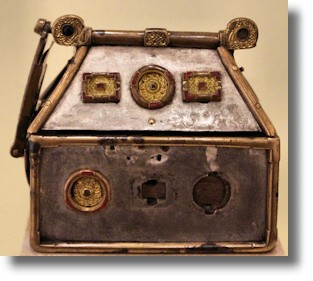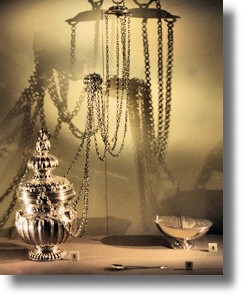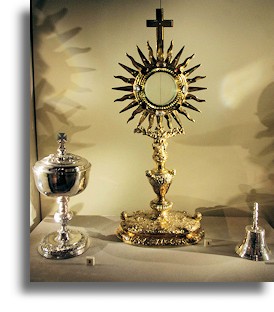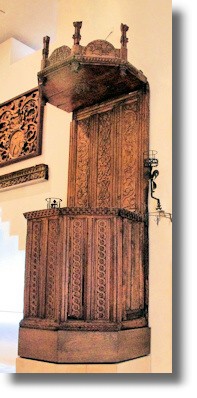
Places to Visit in Scotland - National Museum of Scotland
Christianity

The early church left an indelible mark on the country, not just in abbeys and churches but also in stone carvings and ornamentation.
The Monymusk Reliquary
A picture of the Monymusk Reliquary is shown above. It is a small 8th century wooden box shaped like an oratory and covered in bronze and silver plates. It is decorated with semi-precious stones and enamel. It was believed to contain a bone relic of St Columba. King William the Lion entrusted it to the abbot of Arbroath in 1211 and it was kept at the Monymusk Priory, Aberdeenshire for many years. It was to be kept available to bless the royal army before battle - and was used to good effect in this way before the Battle of Bannockburn in 1314. In recent years it has been kept in the National Museum of Antiquities in Edinburgh but it is now on display at the Museum of Scotland
St Andrew
This carving of St Andrew is made of oak and was made around 1500.
St Andrew was the fisherman brother of St Peter. He was reputedly crucified at Patras on a cross of X shape. Relics of the saint were brought to Fife, possibly by St Regulus in the 4th century. He is said to have obtained them from Patras and being charged to deliver them in 'a region towards the west, situated in the utmost part of the world'. This turned out to be Scotland where Regulus came ashore after being shipwrecked at Kinrymont (later renamed St Andrews). Another version credits a Pictish King Angus or Oengus with bringing the relics from Northumberland in the mid-8th century
Some accounts also add a visionary element in which St Andrew (or his cross) makes a personal appearance to ensure a Scots or Pictish victory by the Pictish King Angus in the 8th or 9th century. Legends say the cross appeared in the sky (white clouds in a blue sky - hence the Scottish Saltire flag) during a decisive battle.
The saint became Scotland's patron, and the site a royally patronised place of pilgrimage which in 908 also became the see of the only Scottish bishopric at that time.
Silverware


The church could afford to create expensive, beautiful objects for use in their services. The illustration on the left is of a "Thurible" which was used to burn incense.By passing water through the symbolic sun, topped by a cross, the priests consecrated water (see picture on the right). This item is part of silver plate made for Roman Catholic worship after the Reformation had established Protestantism in Scotland in the 16th century. The silver was paid for by the Earl of Perth, King James VIII's chancellor. But in 1688 the chapel at Holyrood in Edinburgh was ransacked by a mob but some of the items, including this monstrance was rescued by one of the priests.
Illustrated here is a "Book of Common Order" or "Knox's Liturgy" printed in Middleburg, the Netherlands in 1602. Setting out the rules and procedures for the reformed Church of Scotland, about 70 editions of the book were printed in the Netherlands for the church between 1560 and 1645.
Later Symbols

The carved oak pulpit dated 1598 shown on the left is from Parton Kirk in Kirkcudbright. It is inscribed "Feir (fear) the Lord and Honour His Hous." It comes from after the Reformation when the pulpit was placed in the centre of the church, in order to bring the Word of God and the sermon into the centre of worship. It is similar, however, to pre-Reformation pulpits in having a panelled backboard and sounding board or canopy and in being conservative in decorative style.
Those convicted of various offences by the kirk session were required to appear before the congregation in a plain gown of sackcloth such as the one shown on the right from west Calder. Records show that a Janet Gothskirk had to appear on successive Sundays for many months for her adultery with a local man. She was eventually excused because of the "nearness of her delivery". There is no record of any punishment of the man with whom she had her liaison. Beside the gown is a "stool of repentance" from Old Greyfriars church in Edinburgh. Those who had broken society's rules sat on the stool while the church minister delivered a sermon on his or her sin. Apparently the bigger the sin, the longer the sermon!
The horse-drawn hearse shown below comes from East Lothian. It is decorated with the symbols of death and tears. Part of the hearse may come from a mid-17th century coach, making it the oldest surviving road vehicle in Scotland.
More Pages on the Museum of Scotland
For more on the National Museum of Scotland, see:
Return to the Main Index of Places to Visit
Where else would you like to go in Scotland?

